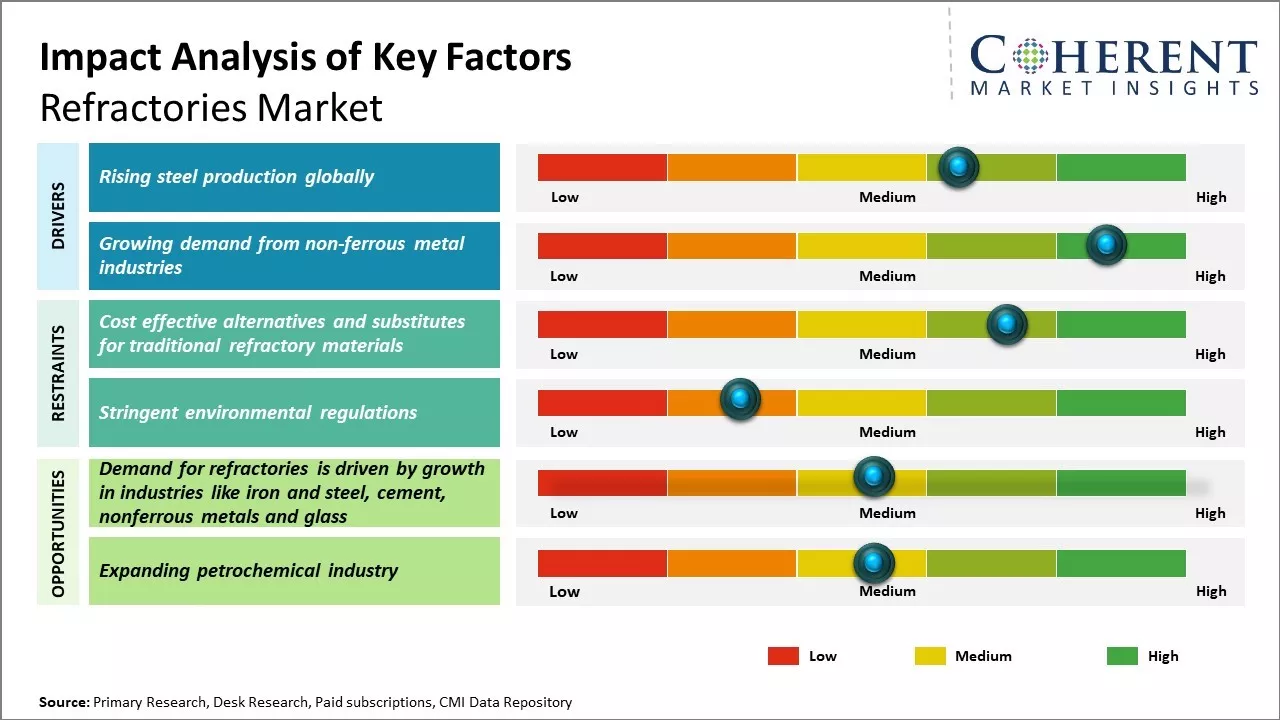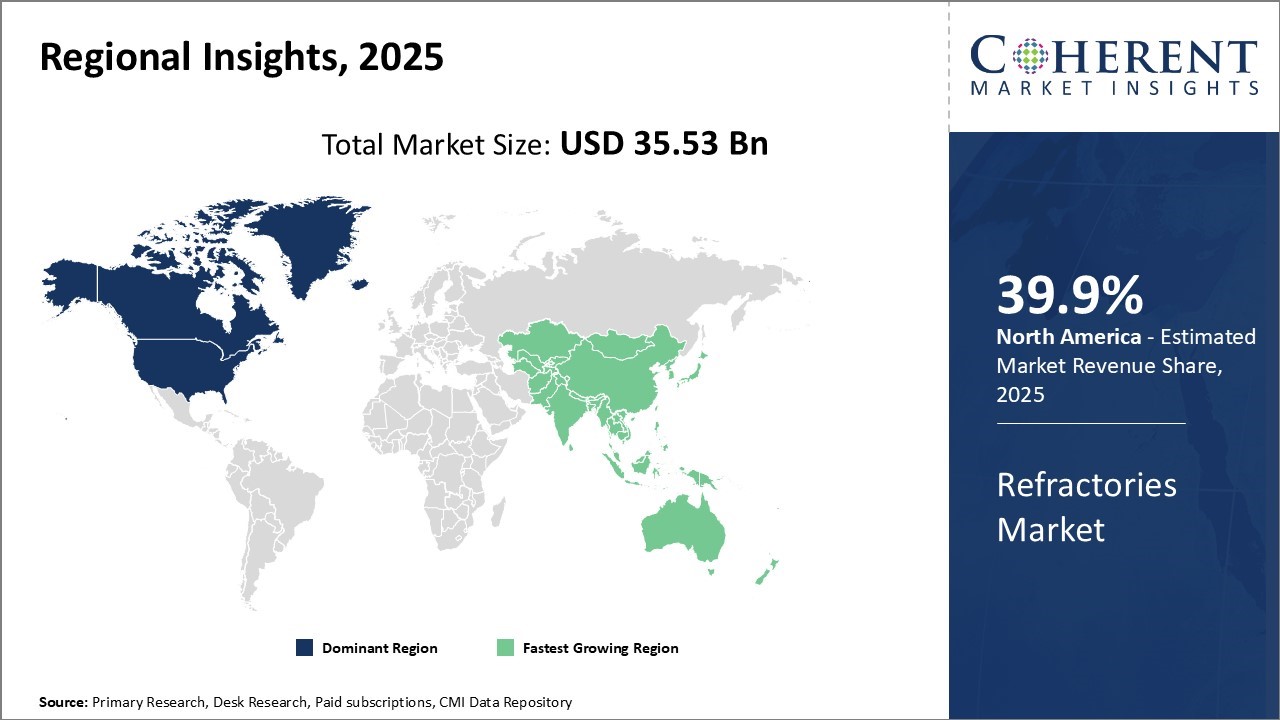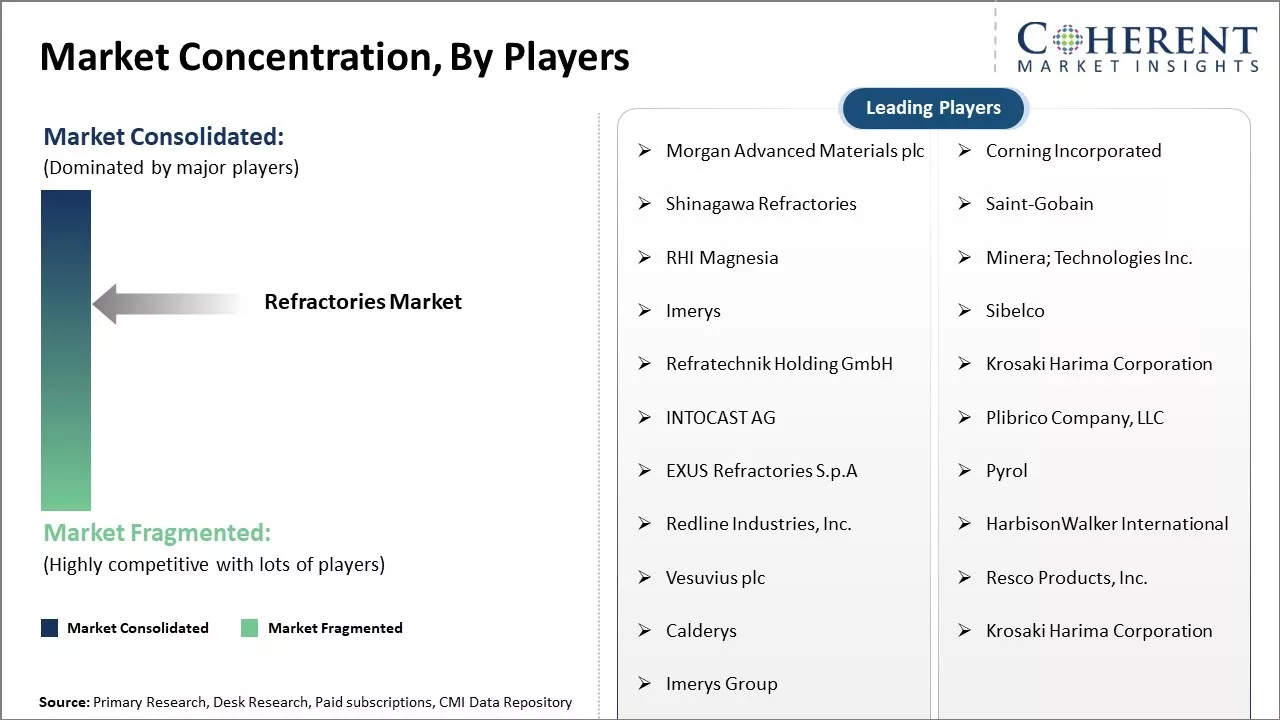The refractories market is estimated to be valued at USD 35.53 Bn in 2025 and is expected to reach USD 47.11 Bn by 2032, growing at a compound annual growth rate (CAGR) of 4.1% from 2025 to 2032.

To learn more about this report, Download Free Sample
Refractories are heat-resistant materials that are widely used in various industries such as iron and steel, cement, non-ferrous metals, glass, and others to line furnaces, reactors, and kilns. The market is expected to witness robust growth over the forecast period. This can be attributed to increasing steel production driven by infrastructure development projects across the globe. Additionally, rising energy demand along with expansion of the power and cement industries will also augment the adoption of refractories. However, volatility in raw material prices may hamper the revenue generation of refractories manufacturers to a certain extent.
|
Current Events |
Description and its impact |
|
Geopolitical Tensions and Sanctions |
|
|
Technological Innovations and Sustainability Trends |
|
|
Regional Infrastructure Investments |
|
Uncover macros and micros vetted on 75+ parameters: Get instant access to report
Bricks & Shaped is expected to contribute 64.2% of the market share in 2025. Bricks & shaped refractories are manufactured as per client requirements in various shapes and sizes which allows for precise fitting inside furnaces and kilns. Their modular production also facilitates easy replacement of worn out or damaged parts. This has increased their usage in areas that demand regular repairs and maintenance such as steel plants and petrochemical units. The ability of bricks & shaped refractories to withstand high corrosion and withstand thermal shock has boosted their popularity. Their resistance to slag penetration and ability to retain strength and density at elevated temperatures elevates their performance compared to other form factors. Additionally, custom designs catering to unique process parameters of different end-use industries have strengthened brand loyalty for major refractory brick producers.
Clay is expected to hold 59.6% of the market share in 2025. Clay refractories utilize locally available raw materials like kaolin and ball clay, thereby involving lower procurement costs compared to other refractory types. Their production also requires less energy and lower firing temperatures, reducing manufacturing expenses. Greater availability of kaolin reserves globally has ensured stable supply chains for clay refractories even during times of resource constraints. The cost benefits have increased their affordability, especially for smaller industries and developing regions. While non-clay types exhibit better corrosion resistance, clay remains the material of choice where budget is a critical factor for purchase decisions.
Sheffield Refractories offers a broad selection of Taphole Clay products, ranging from basic silica-based formulations to advanced resin-free options designed for use in the largest furnaces.
Basic is projected to contribute 69.9% of the market share in 2025. Basic refractories containing magnesium oxide and calcium oxide work exceptionally well in the highly corrosive environment of steel melting shops and ladles. They protect the steel from re-absorption of oxygen and other gases due to their ability to form a protective slag layer. Their resistance to penetration and erosion by molten steel slag at 1,500°C or above has boosted replacements of acidic & neutral refractories in core steelmaking applications. Rapid infrastructure growth and rising vehicle manufacturing in Asian countries in particular has spurred huge demand from the alloy steel sector. The upsurge in crude steel output will continue driving higher consumption of basic refractories designed for slags in primary steelmaking, further enhancing the refractories market share.
The iron and steel industry drives the refractories market by demanding durable, high-temperature resistant materials for furnaces, ladles, and converters. Urbanization and infrastructure development fuel steel demand, which in turn increases refractory consumption. Steelmakers adopt advanced processes like electric arc and basic oxygen furnaces, requiring specialized refractories that resist thermal stress and slag corrosion. Additionally, environmental regulations encourage the industry to develop energy-efficient and sustainable refractory solutions, actively promoting the refractories market revenue. For instance, in November 2024, Vesuvius inaugurated its new alumina-silica and basic monolithic manufacturing plants in Visakhapatnam, reinforcing its support for the Make in India initiative. With these facilities, Vesuvius continues to invest in India to improve its production capabilities and meet the growing demands of the iron and steel industries.

To learn more about this report, Download Free Sample
Key industries like steel, cement, glass, and non-ferrous metals are driving significant growth in the North American refractories market. Infrastructure investments, with over $300 billion allocated to public sector projects, are increasing the demand for high-performance refractories in construction and manufacturing. Companies are adopting technological advancements, including automation in furnace maintenance and developing energy-efficient, environmentally compliant refractory materials, which improve operational efficiency and promote sustainability.
A subsidiary of Aluma Systems Intermediate Holdings Inc.—which is itself owned by Brand Industrial Services Inc., operating under the name BrandSafway—has acquired Alliance Refractories Ltd. (Alliance), the top refractory company in Western Canada.
China and India lead global steel production and drive strong demand for refractories. Expanding steelmaking capacities require high-performance refractory materials to endure extreme heat and corrosive conditions in blast furnaces and converters. This trend highlights refractories’ vital role in the steel industry's growth. Additionally, governments across Asia Pacific invest heavily in infrastructure projects like roads, bridges, and urban development. These projects increase demand for cement and lime, which boosts the need for refractories in kilns and other high-temperature applications.
In March 2025, Zhongrong Intelligent Equipment (Jiangsu) Co., Ltd., a wholly-owned subsidiary of Zhongzhu New Materials Industry (Jiangsu) Co., Ltd., based in China, launched its new manufacturing facility. The commissioning of the 17,500 m² workshop marks a significant expansion of the company’s production capabilities. With this addition, the company now has the capacity to produce 6,000 metric tons of precast components and 200 units of high-end equipment annually. Furthermore, its annual output of unshaped refractory materials is set to reach 100,000 metric tons, further accelerating the refractories market demand.
The U.S. steel industry is increasingly shifting from traditional blast furnaces to electric arc furnaces (EAFs). EAFs reduce energy consumption, lower emissions, and enable the use of recycled scrap metal. This shift boosts demand for refractories that endure rapid thermal cycling and harsh slag conditions. Manufacturers follow strict standards set by the Environmental Protection Agency (EPA) and the Occupational Safety and Health Administration (OSHA), which shape production methods and product innovation in the refractories market.
For instance, RHI Magnesita acquired multiple refractory plants across the U.S. The acquired company is a specialist in non-basic shaped refractories.
China’s iron and steel industry consumes the largest share of refractories. The industry relies on refractories to line furnaces, converters, and ladles, highlighting their vital role in supporting strong steel production. Manufacturers increasingly prefer monolithic refractories, such as castables and gunning mixes, over traditional bricks because they install easily, reduce downtime, and adapt well to complex furnace shapes in high-temperature applications, further proliferating the refractories market share.
SEFPRO has announced the formation of a joint venture with Anhui Sino-Refractory Technology Co. to strengthen its high-performance fused cast refractory product offering for the glass industry in China.

To learn more about this report, Download Free Sample
| Report Coverage | Details | ||
|---|---|---|---|
| Base Year: | 2024 | Market Size in 2025: | USD 35.53 Bn |
| Historical Data for: | 2020 To 2024 | Forecast Period: | 2025 To 2032 |
| Forecast Period 2025 to 2032 CAGR: | 4.1% | 2032 Value Projection: | USD 47.11 Bn |
| Geographies covered: |
|
||
| Segments covered: |
|
||
| Companies covered: |
Morgan Advanced Materials plc, Corning Incorporated, Shinagawa Refractories, Saint-Gobain, RHI Magnesia, Minera; Technologies Inc., Imerys, Sibelco, Refratechnik Holding GmbH, Krosaki Harima Corporation, INTOCAST AG, Plibrico Company, LLC, EXUS Refractories S.p.A, Pyrol, Redline Industries, Inc., HarbisonWalker International, Vesuvius plc, Resco Products, Inc., Calderys, Krosaki Harima Corporation, and Imerys Group |
||
| Growth Drivers: |
|
||
| Restraints & Challenges: |
|
||
Uncover macros and micros vetted on 75+ parameters: Get instant access to report
The steel industry continues to be the largest consumer of refractories due to its high-temperature processes requiring durable materials. Increasing steel production worldwide, driven by infrastructure development and industrial growth, fuels demand for advanced refractories that can withstand intense heat, thermal shock, and chemical corrosion. Global steel production capacity is expected to grow by 165 million metric tons between 2025 and 2027. Manufacturers focus on producing materials with enhanced lifespan and resistance, supporting the steel sector’s efficiency and cost-effectiveness, while meeting evolving environmental and regulatory requirements.
The global push toward clean energy is opening new opportunities for refractories. Emerging sectors like hydrogen production and renewable energy infrastructure require high-temperature systems for electrolysis, fuel processing, and energy storage. These applications demand advanced refractories that withstand thermal cycling, chemical attack, and mechanical stress. As investments in green hydrogen and sustainable energy accelerate, refractory manufacturers have the opportunity to develop tailored solutions that support high-efficiency, low-emission operations in next-generation energy facilities.
Share
Share
About Author
Ramprasad Bhute is a Senior Research Consultant with over 6 years of experience in market research and business consulting. He manages consulting and market research projects centered on go-to-market strategy, opportunity analysis, competitive landscape, and market size estimation and forecasting. He also advises clients on identifying and targeting absolute opportunities to penetrate untapped markets.
Missing comfort of reading report in your local language? Find your preferred language :
Transform your Strategy with Exclusive Trending Reports :
Frequently Asked Questions
Joining thousands of companies around the world committed to making the Excellent Business Solutions.
View All Our Clients